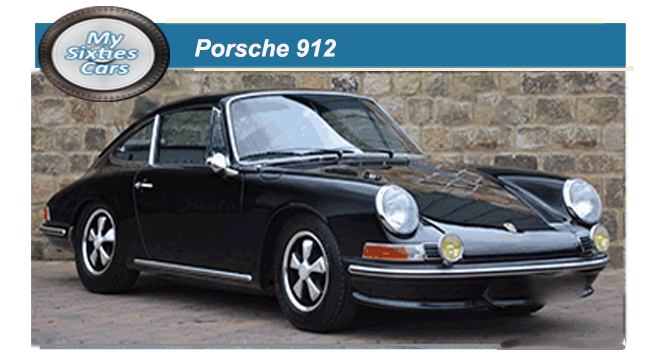
As the development of the 911 progressed, the penny must have dropped at Porsche that their new model, muted as the successor to the ultra-successful 356 series, was going to turn out to be an expensive motor car.
To keep within the radar of potential buyers whose budget was limited, Porsche began to develop what was, ostensibly a scaled-down version of the 911, which they once again showed a lot of imagination by naming it the 912.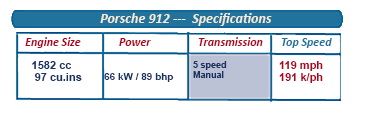 According to the mid-Sixties motoring media, Porsche had no intention that the 912 be regarded as the natural successor to the 356., despite having a very similar price tag and the fact that a substantial number of components used in the 356 continues to be used on the 912.
According to the mid-Sixties motoring media, Porsche had no intention that the 912 be regarded as the natural successor to the 356., despite having a very similar price tag and the fact that a substantial number of components used in the 356 continues to be used on the 912.
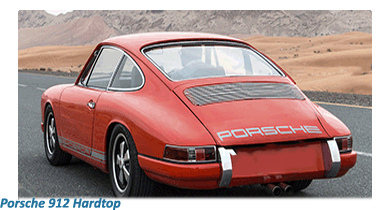 Its external appearance and technology employed was almost a direct copy of the 911- but with a lot less power, a factor that was compensated by a considerably reduced price ticket.
Equipped with the same 1582 cc litre flat-four engine latterly fitted on the 356 SC, matched up to 4-speed manual transmission, the Porsche 912,as was the case with the 911, was a rear-engined car.
Apparently looking at every means and method to reduce costs on the 912, without compromising on the overall quality and robustness of the vehicle, Porsche carefully examined every area, to reduce costs without foresaking quality.
Its external appearance and technology employed was almost a direct copy of the 911- but with a lot less power, a factor that was compensated by a considerably reduced price ticket.
Equipped with the same 1582 cc litre flat-four engine latterly fitted on the 356 SC, matched up to 4-speed manual transmission, the Porsche 912,as was the case with the 911, was a rear-engined car.
Apparently looking at every means and method to reduce costs on the 912, without compromising on the overall quality and robustness of the vehicle, Porsche carefully examined every area, to reduce costs without foresaking quality.
![]()
For example, dashboards on the 912 came finished in the same colour as the car’s exterior, and not the matte black used on the 911, while there were no traces of wooden trim in the 912 cockpit.
Among the many other cost-cutting exercises employed by Porsche was reducing the number of gauges in the cockpit from three to five, and most significantly reducing the number of gears available from five to four.
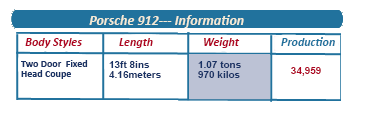 Whether by accident or desire, Porsche succeeded in producing a first-class vehicle with the 912, and possibly too close a rival to the 911 than they might have been fully comfortable with.
Whether by accident or desire, Porsche succeeded in producing a first-class vehicle with the 912, and possibly too close a rival to the 911 than they might have been fully comfortable with.
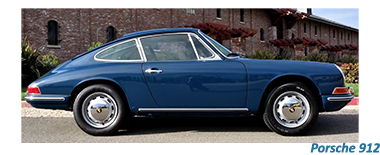
One of the major problems experienced in the earlier versions of the 911 was its inferior weight displacement, with the bulk of the weight was at the rear of the vehicle, causing the early versions of the 911 to suffer from erratic road holding, a problem not experienced by the 912.
Porsche soon put the problems experienced on the 911 right, with the model undergoing regular mechanical updates during the Sixties, while the 912 remained in much the same mechanical format during its five-year production run, in line with the cosmetic evolution of the 911.
![]()
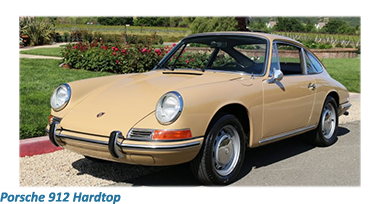 Production of the 912 was eventually discontinued in 1969 with demand falling.
Production of the 912 was eventually discontinued in 1969 with demand falling.
Porsche did re-release the 912 in the mid-Seventies, fitted with a VW-powered 912E engine. The model was specifically aimed towards the United States market, in response to the oil crisis of the times.
Despite Porsche’s magnanimous gesture to play their part in fighting “gas guzzling” the American public was mostly disinterested, meaning that the 912 was rapidly put to rest after being in production for less than two years. The 912 established the line's performance credentials, though initially there were several initial problems, which Porsche rapidly ironed out, going on to consistently update and improve the model till it became a legend in its own lifetime.






